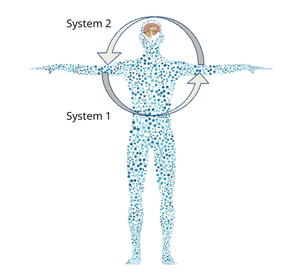System 1 versus System 2
Introduction
Research has analyzed how our decisions are influenced by our intuition and can be refined to lead to better decisions. This new framework has important implications for how we think and make decisions about ourselves and people in general, and what can be potentially done beyond simply mastering awareness of our potential biases.
System 1 and System 2
Daniel Kahneman’s book, Thinking, Fast and Slow, is a masterpiece on intuition research and explains how intuition works[1]. The book helps reshape the way we look at people and how they make decisions. As explained by Kahneman, intuition can be considered as two systems that are working in parallel, System 1 and System 2:
- System 1 is automatic, quick, and requires no effort. It’s the “no-brainer” of decision-making. We are at ease with it; trust the outcomes to a point that we don’t even think about it. When you speak, walk, drive, get distracted by an unusual event, and are at ease doing all of this, that’s System 1.
- System 2 requires attention, mental activities, concentration, and effort to reason or calculate. Cleaning your desk or filing taxes, remembering what you did five years ago at a specific event, making a difficult mathematical calculation in writing, deciding how you’ll take vacation, or thinking deeply to solve a complex issue is what System 2 is about.
System 1
System 1 continually assesses what is happening either from within us or outside us, our environment. It allows instant answers and adaptation without reaching for the more elaborate cognition of System 2. System 1 allows instant perception and reaction to friendly or hostile situations.
System 1 has the tendency to jump to conclusions without having all the facts. Most questions from our System 1 are emotionally loaded. There are frequently multiple factors and complex questions involved in solving them. By keeping the unexpressed questions that we ask from our System 1 open to discussion, we allow for more effective answers and solutions to emerge.
With our System 1 intuition, these biases are a natural part of the mental machinery that operates within us. They are effortless natural phenomena that we are all subject to, not defective processes as the term “bias” may lead us to believe.
System 2
Two important characteristics of System 2 are that it requires attention and effort. As evidenced by research, switching from System 1 to System 2 comes with mental and physical effects. We don’t do it until it’s necessary. It’s not part of System 1, and we can master it only after training, exercise, and multiple repetitions over time.
System 2 carries out our action or decision and may correct the course of our thinking by consciously reminding us of the irrelevancy of the characteristic. This assists us in reframing the decision or helps us come up with a substitute.
Stereotyping can be part of System 2 as well as System 1. In System 2, it is a way of consciously assigning people to categories based on one characteristic. In System 1, these categories are acted upon unconsciously, effortlessly priming our impressions, attitudes, and decisions about people, whether we want them to or not.
Interaction Between the two Systems
The two systems interact with each other. When System 1 meets some inconsistencies, difficulties, constraints, or other challenges, then System 2 takes over. With our System 1 autopilot we are continuously provided with actions and answers to abundant questions that work on their own. Do I feel good about Jane or Bob? System 1 instantly provides the answer. How do I effortlessly communicate with my teammates? Again, System 1 is in action, as it is continuously.
How should I adjust my communication to be more effective when speaking to a large audience? System 2 may have to operate here, at least until the behavior becomes natural.
Parallel with GRI's Adaptive Profiles
Observations of System 1 and System 2 concur with those we've evidenced with the Natural and Role profiles of GRI's adaptive profiles. The Natural profile represents System 1: how we behave, think, and feel about how we act spontaneously, effortlessly, and instinctively.
Adaptation happens with System 2, as we represent it with the Role profile. Adapting requires some thinking and control of our feelings and behaviors. The Effective profile, as a result of the two systems acting concomitantly, represents the behavior that others may most probably observe, not the Natural nor the Role.
Notes
- ↑ Kahneman, D. (2011). Thinking, Fast and Slow. New York: Farrar, Strauss and Giroux.

